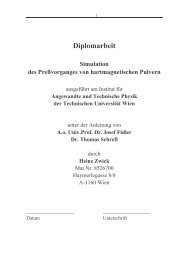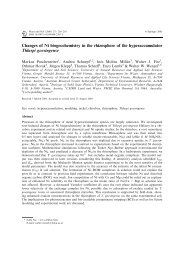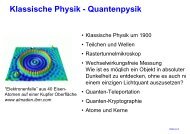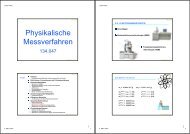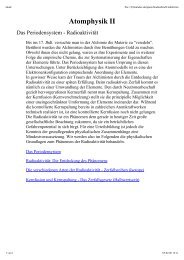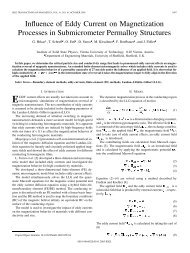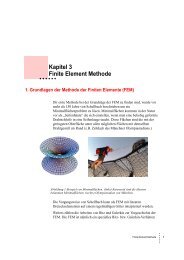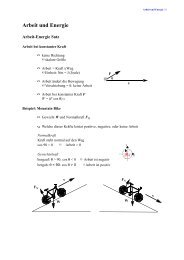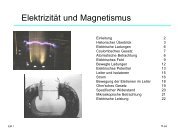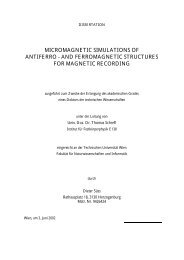Read Back Signals in Magnetic Recording - Research Group Fidler
Read Back Signals in Magnetic Recording - Research Group Fidler
Read Back Signals in Magnetic Recording - Research Group Fidler
Create successful ePaper yourself
Turn your PDF publications into a flip-book with our unique Google optimized e-Paper software.
out <strong>in</strong> <strong>in</strong><br />
2 2 1<br />
∂V<br />
Numerical Methods<br />
H − H = H (4.61)<br />
to guarantee (4.50) and (4.53). Aga<strong>in</strong> we have an equivalent problem as <strong>in</strong> Section 4.2, but for<br />
three dimensions. Analogously the field H 2 can be evaluated by<br />
( − ′ )<br />
1 r r n<br />
H () r = ( ′ ) dA<br />
π � ∫ H r<br />
. (4.62)<br />
′<br />
2<br />
4 ∂V<br />
<strong>in</strong><br />
1<br />
r−r 3<br />
To save memory we only create an <strong>in</strong>teraction matrix from boundary to boundary, and solve<br />
the Laplace equation (4.60) aga<strong>in</strong> to calculate H 2 .<br />
4.4.6 Example: Long Wire<br />
To verify the program and the calculated fields, some relative simple models are simulated,<br />
which can also be calculated analytically. The first example is a long straight Cu-wire with<br />
length l = 200 mm and wire radius r = 2 mm . The conductivity of Cu is<br />
7 -1 -1<br />
σ= 5.961⋅10 Ω m . At least we have to specify the boundary conditions of the wire. At one<br />
side the electric potential was set to V 1 = 0 . The boundary condition of the opposite end was<br />
chosen <strong>in</strong> a way, that the total <strong>in</strong>flow<strong>in</strong>g current has a value of I = 1 mA . With these<br />
parameters the total resistance of the Cu-wire can be calculated: R = 267 µ Ω . Us<strong>in</strong>g Ohm’s<br />
Law (2.1) we get for the electric potential V 2 = 0.267 µV . This analytically calculated value<br />
matches well with that of the FEM calculation 2<br />
0.278 µV<br />
FEM<br />
FEM<br />
V = . The error ( 2<br />
V is about<br />
4.2% larger than V 2 ) is traced back to the mesh. The mesh has to approximate a cyl<strong>in</strong>drical<br />
surface with triangles. So the cross sectional area of the mesh model is smaller than that of the<br />
realistic model. This leads to a larger resistance and further to a larger voltage.<br />
I<br />
2<br />
The current density of the realistic model is j = = 79.58 A/m . The magnetic field of an<br />
2<br />
r π<br />
<strong>in</strong>f<strong>in</strong>ite long straight wire with constant current can be easily calculated due to the symmetry<br />
<strong>in</strong> respect of rotations around the wire’s axis. The only non-zero field component is that <strong>in</strong><br />
azimuthal direction and can be determ<strong>in</strong>ed us<strong>in</strong>g Ampere’s Law (2.6).<br />
� ∫ H⋅ ds= ∫j×<br />
dA<br />
(4.63)<br />
∂A<br />
A<br />
54



